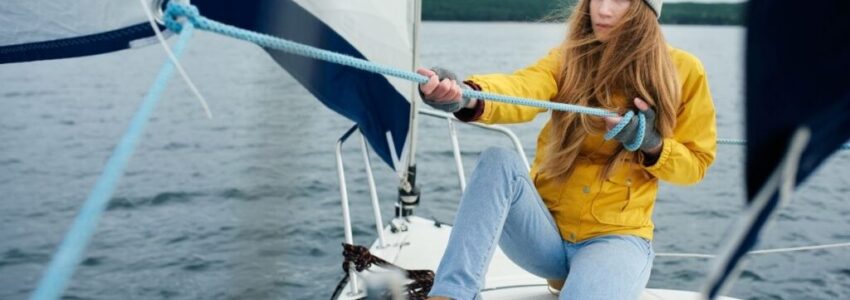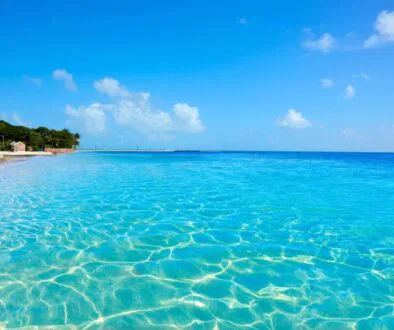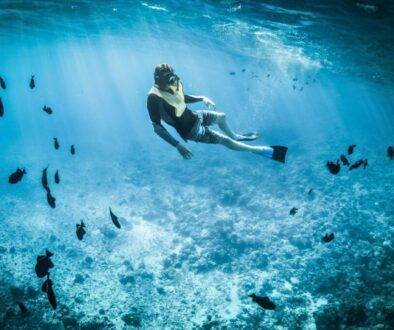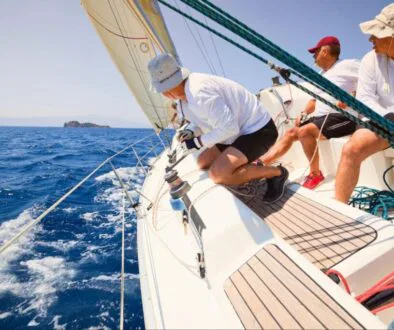Windward vs. Leeward: A Quick Guide for Sailors

Published October 4, 2022
The ability to understand how sails work will undoubtedly add up to your most valuable skills.
Sailing a boat is relatively easy if you have a good understanding of sailing theory. As you learn new concepts as a sailor, you’ll be able to sail quicker and more safely in any situation.
In this article, you’ll understand the difference between windward and leeward, what a sail shape is, what push and lift mean, and what the keel is. Read on to learn more.
Defining Leeward vs. Windward Sailing
The windward side of an island confronts the predominant trade winds, whereas the leeward side faces away from the wind, protected from it by hills and mountains.
As the trade winds travel across the ocean, they gather moisture from the surrounding sea. Once the moist air reaches the island’s landmass, it ascends the island’s hills and mountains, forming condensation, clouds, and precipitation. The air heats and dries as it travels to the other half of the island.
Hence, the windward side of an island is wetter and more verdant than the leeward side, which is dryer. This disparity is referred to by meteorologists as the orographic effect.
For instance, the Hawaiian Islands typically have damp windward sides and dry leeward sides due to the Pacific Ocean’s northeasterly trade winds. Generally, windward locations are lush and verdant. The islands’ more sheltered leeward shores are home to famous beaches like Oahu’s Waikiki and Maui’s Wailea.
Windward Vs. Leeward: What’s The Difference?

First and foremost, you should know the difference between the terms windward and leeward, as in “you’re windward if you’re on the leeward side of the boat.”
A windward island is closer to the wind on a sailing boat, while a leeward island is further away from the wind. Let’s use the example of a boat to clarify: Windward is the side the wind hits first, while “to leeward” is the opposite side.
Sailboats experience constant wind shifts across, not from behind or ahead. Therefore, these terms will most likely come up often.
What is Sail Shape?
Sailing science begins with the sail’s rounded, triangular shape. The sail’s frontmost edge links with the mast, while the bottom edge travels horizontally along the boom.
A very slight curve has been applied to the sail, which allows it to billow ever so slightly.
What Does “Push And Lift” Mean?
The resulting curvature provides two power types with a rounded sail – push from the wind to the windward side of the sail and lift from the wind rushing on the leeward side.
Wind push is intuitive. This means that the wind is pushing the sail in the same direction.
Lift, on the other hand, is a bit more challenging to explain. Like the wings of the aircraft, sails create changes in air pressure which pull the boat forward.
For instance, when the boom is positioned roughly 45 degrees to the wind, wind separates at the mast, dividing equally the leeward and windward sides of the sail.
As a result, the wind blows opposite the windward side, causing the sail to fill and creating a curving wing. Leeward winds follow this curve, sticking to it according to physics and then increasing speed to keep pace with the windward sibling.
Because of that, there is a reduction in pressure, and therefore, there is a suction effect that pulls the boat leeward.
Without this certain curved sail shape, the lift cannot occur. To keep the sail round and full, the wind should constantly touch the windward side. The sails will not work if there isn’t enough wind on the windward side to fill the sail. Like a flag, they’ll just flap uselessly in the wind.
What Is A Keel?
With a push from windward and lift from leeward added, the force of the wind is no longer pointed directly ahead but angled to a degree. A keel is positioned beneath the boat and opposes the sideways motion, minimizing the distance the boat has to turn when it’s being pushed along.
As sails generate power from the wind, they both generate lift and push. To have an efficient flow of wind power, the sails are placed at an angle to the apparent wind, which is the wind felt by a moving ship. To the degree that genuine wind direction can be felt from a fixed location, the route with regard to the actual wind direction is called a point of sail.
Sails on the point of sail that are facing toward the wind cannot provide propulsion to a conventional sailing vessel. To create resistance to the forces transferred via the sails, the hull, keel, and rudder of a sailing craft, the wheels of a land sailing vessel, or the skate runners of an iceboat have to oppose those forces.
Now that you are aware of the difference between Windward vs. Leeward, other terms, and how they all work together, you can now try sailing on your next Hawaii vacation and expand your skills.
Experience Yacht Charters With Seafari In Boca Raton Florida
Looking for a great time on the water in Boca Raton Florida? Seafari Yacht Charters is number choice for yacht rentals in Boca Raton. Book our yachts for parties, exciting day trips to the Bahamas, romantic yacht dinner cruises, and much more. Come experience all South Florida has to offer with us.

Fact Checked By Experts
Our team of internal experts has conducted rigorous fact-checking on this content. Explore the editorial standard for our website to dive deeper into our commitment to excellence.

About The Author
Christian Cruz is passionate about yachting and South Florida life. As a professional blogger he has reached millions of people around the world with his work.



